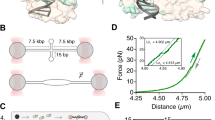Abstract
The spontaneous interaction of homologous linear DNA fragments was studied with a model of purified PCR products by agarose gel electrophoresis. To interact, duplexes required not only homology of internal regions, but also complementary ends. Fragments differing in terminal sequences did not interact. The yield of Holliday junctions (HJ), the simplest product of DNA–DNA interaction, depended on dissociation of fragment ends. Compared with genomic fragments, those with low-melting AT ends interacted with each other more efficiently and those with high-melting GC ends, less efficiently. Incubation temperature affected the equilibrium HJ concentration in solution of homologous fragments. A conclusion was made that HJ formation is initiated by nucleation of dissociated duplex ends.
Similar content being viewed by others
REFERENCES
Gierer, A., Nature, 1966, vol. 212, pp. 1480–1481.
Holliday, R., Genet. Res. Camb, 1964, vol. 5, pp. 282–287.
Potter, H. and Dressler, D., Proc. Natl. Acad. Sci. USA, 1976, vol. 73, pp. 3000–3004.
Bell, L. and Byers, B., Proc. Natl. Acad. Sci. USA, 1979, vol. 76, pp. 3445–3449.
Whithouse, H.L.K., Genetic Recombination: Understanding the Mechanism, New York: Wiley, 1982, p. 211.
Postow, L., Ullsperger, C., Keller, R.W., et al., J. Biol. Chem., 2001, vol. 276, pp. 2790–2796.
Wasserman, S.A. and Cozzarelli, N.R., Science, 1986, vol. 232, pp. 951–960.
Cox, M.M. and Lehman, I.R., Annu. Rev. Biochem., 1987, vol. 56, pp. 229–254.
Lopez, B., Rousset, S., and Coppey, J., Nucleic Acids Res., 1987, vol. 15, pp. 5643–5655.
Cotton, R.G.H., Mutation Detection, Oxford: Oxford Univ. Press, 1997, p. 281.
Ronai, Z. and Yakubovskaya, M.G., J. Clin. Lab. Anal., 1995, vol. 9, pp. 269–281.
Lu, M., Guo, Q., Marky, L.A., et al., J. Mol. Biol., 1992, vol. 223, pp. 781–789.
Yakubovskaya, M.G., Neschastnova, A.A., Humphrey, K.E., et al., Eur. J. Biochem., 2001, vol. 268, pp. 7–14.
Yakubovskaya, M.G., Neschastnova, A.A., Lipatova, Zh.V., et al., Biokhimiya, 1999, vol. 64, pp. 1550–1554.
Gaillard, C. and Strauss, F., Science, 1994, vol. 264, pp. 433–436.
Gaillard, C., Flavin, M., Woisard, A., et al., Biopolymers, 1999, vol. 50, pp. 679–689.
Saenger, W., Principles of Nucleic Acid Structure, New York: Springer, 1984. Translated under the title Printsipy strukturnoi organizatsii nukleinovykh kislot, Moscow: Mir, 1987.
Doktycz, M.J., Morris, M.D., Dormady, S.J., et al., J. Biol. Chem., 1995, vol. 270, pp. 8439–8445.
Duckett, D.R., Murchie, A.I., Diekmann, S., et al., Cell, 1988, vol. 55, pp. 79–89.
Panyutin, I.G. and Hsieh, P., Proc. Natl. Acad. Sci. USA, 1994, vol. 91, pp. 2021–2025.
Neschastnova, A.A., Markina, V.K., Danilova, O.A., et al., Biochemistry, 2002, vol. 41, pp. 7795–801.
Belotserkovskii, B.P. and Johnston, B.H., Anal. Biochem., 1997, vol. 251, pp. 251–262.
Nonin, S., Leroy, J.L., and Gueron, M., Biochemistry, 1995, vol. 34, pp. 10652–10659.
Leijon, M. and Graslund, A., Nucleic Acids Res., 1992, vol. 20, pp. 5339–5343.
Porschke, D., Mol. Biol. Biochem. Biophys., 1977, vol. 24, pp. 191–218.
Marky, L.A., Kallenbach, N.R., McDonough, K.A., et al., Biopolymers, 1987, vol. 26, pp. 1621–1634.
Belotserkovskii, B.P. and Zarling, D.A., J. Biomol Struct. Dyn., 2000, vol. 17, pp. 1057–1075.
Belotserkovskii, B.P., Reddy, G., and Zarling, D.A., Biochemistry, 1999, vol. 38, pp. 10785–10792.
Author information
Authors and Affiliations
Rights and permissions
About this article
Cite this article
Markina, V.K., Danilova, O.A., Neschastnova, A.A. et al. The Role of Duplex Ends in the Spontaneous Interaction of Homologous Linear DNA Fragments. Molecular Biology 36, 693–697 (2002). https://doi.org/10.1023/A:1020679531678
Issue Date:
DOI: https://doi.org/10.1023/A:1020679531678




